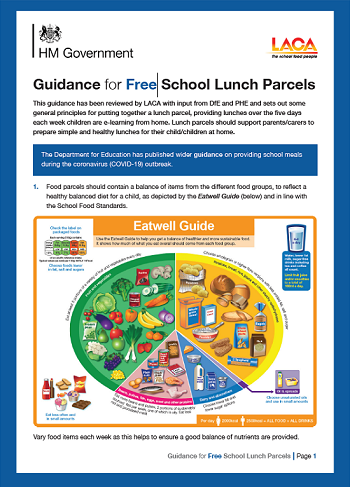Guidance for Free School Lunch Parcels
The School Food Guidance has been updated to include information on providing school meals from 8 March 2021.
This guidance has been reviewed by LACA with input from DfE and PHE and sets out some general principles for putting together a lunch parcel, providing lunches over the five days each week children are e-learning from home. Lunch parcels should support parents/carers to prepare simple and healthy lunches for their child/children at home.
1. Food parcels should contain a balance of items from the different food groups, to reflect a healthy balanced diet for a child, as depicted by the Eatwell Guide (see below) and in line with the School Food Standards.
Vary food items each week as this helps to ensure a good balance of nutrients are provided.
Each parcel should provide:
- Starchy foods
A variety of different types (such as bread, potatoes, pasta), to enable lunches to be based on these.
1 loaf of bread or pack of 10-inch wraps
AND
3 baking potatoes or 1 pack of pasta / rice
Include some wholegrain varieties where possible, such as wholemeal bread. - Fruit and vegetables
A variety of different types, to provide at least one portion of fruit and one portion of vegetables each day.
Include at least three of the following examples:
1 cucumber, 5 large tomatoes / 1 pack of cherry tomatoes, 1 tin of sweetcorn in water, 5 carrots, 1 red pepper, 1 head of broccoli etc.
AND
Five portions of fresh fruit (e.g. apples, satsumas, bananas) OR 3 portions of fresh fruit + 1 tin of fruit in juice (e.g. pears, peaches, fruit cocktail) - Protein foods
Protein foods (such as beans, pulses, fish, eggs, meat and other non-dairy proteins), to provide a portion of food from this group every day.
Include at least two of the following:
1 pack sliced cooked meat (e.g. ham, chicken), 1 tin fish (e.g. tuna, salmon), 6 eggs, 1 tin of meat, 1 tin of lentils/pulses
AND
2 tins of baked beans - choose lower salt baked beans where possible
Meat and fish should be cooked or tinned. Consider alternating between different protein foods to provide variety - Dairy and/or dairy alternatives
Dairy and/or dairy alternatives (such as milk, cheese, yoghurt), to provide a portion of food from this group every day, such as:
200g block of cheese + 1 litre of semi-skimmed milk
AND
500g pot plain lower-fat yoghurt OR 5 individual serving yoghurt pots - Additional Items
Consider also including:
Fruit malt loaf (190g or 5 individual bars)
1 jar of tomato- based pasta sauce (if providing pasta)
2. Food parcels should not contain items restricted under the School Food Standards (e.g. chocolate, confectionery, crisps). The Standards allow desserts at lunchtime, and the items given as examples (i.e. fruit or lower-fat fruit yoghurt) would be good dessert options.
Any pre-prepared meals provided must also meet School Food Standards.
3. The examples above of the types and quantities of foods that could be included in a parcel has been based on information from school caterers (taking into consideration additional costs such as distribution) and are for illustrative purposes. Parcels can also be supplemented by food from the School Fruit and Vegetable Scheme which can be added as additional items, especially for those in Key Stage 1.
4. Parcels should cater for all children of school age who require special diets (e.g. allergies, vegetarians, vegan or religious diets) and schools should ensure thereare systems in place to avoid cross-contamination. The Department for Education haspublished allergy guidance for schools. Parents may wish to discuss any concerns about their child’s allergies with schools, to ensure that a lunch parcel is suitable or if an alternative method of support such as a voucher may be more suitable.
More guidance on handling allergies can be found here
5. Chilled items such as milk may need to be substituted with ambient alternatives if refrigeration is not possible. Caterers should prepare for food parcels by ensuring they have sufficient stocks of domestic-sized items such as tinned goods. All products used should be clearly labelled and have any best before/use by dates clearly shown.
6. Families and schools may find 5 day lunch parcels easier than a more frequent approach. Minimise the fridge and freezer space needed to store foods, and do not rely on families having additional ingredients at home to prepare meals. Caterers will already be working closely with their schools on the make-up of their lunch parcels.
Meal suggestions using items from the parcels might include:
Beans on toast or jacket potato and beans with grated cheese
Tuna or salmon and Cucumber Sandwich with cherry tomatoes
Tuna and sweetcorn on Jacket Potato
Cheese and tomato sandwich with cucumber or carrot sticks
Cheese, tomato and broccoli omelette with toast
Cheese on toast with tomato and cucumber sticks
Chicken, ham or tuna pasta bake
- using pasta, tuna or sliced cooked meat, and pasta sauce
Cook the pasta in boiling water, drain and mix all ingredients together, sprinkle with grated cheese and bake until golden brown.
Tuna pasta salad, using chopped cucumber, sweetcorn or pepper
Baked tuna, veggie or meat and sweetcorn wrap
- using wraps filled with tinned tuna/meat and sweetcorn, covered in tomato pasta sauce and grated cheese, popped under the grill to heat and melt cheese
Veggie pizza wrap
- using grated cheese, sliced peppers and tomato pasta sauce in a wrap and grilled
Fruit and yoghurt or malt loaf for pudding
The Department for Education has published wider guidance on providing school meals during the coronavirus (COVID-19) outbreak.
DOWNLOAD LACA FOOD PARCEL GUIDANCE PDF
The Eatwell Guide

CLICK HERE TO SEE HOW TO GET THE MOST OUT OF A FREE SCHOOL MEALS PARCEL

